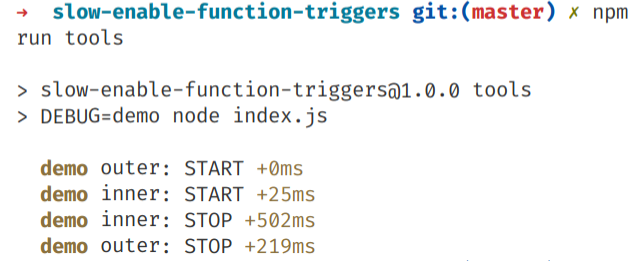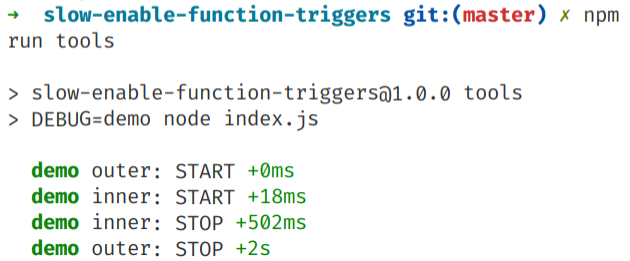firebase-tools
 firebase-tools copied to clipboard
firebase-tools copied to clipboard
Enabling functions triggers after `withFunctionTriggersDisabled` is slower in newer versions of `firebase-tools`
[REQUIRED] Environment info
firebase-tools: 11.2.1
Platform: Ubuntu
[REQUIRED] Test case
Run an empty promise with a 500ms delay in @firebase/rules-unit-testing's withFunctionTriggersDisabled; record the time it takes for the emulator to re-enable function triggers after the task is complete.
[REQUIRED] Steps to reproduce
Prepare project
I have created a reproduction repo at https://github.com/GiacomoRandazzo/slow-enable-functions-triggers.
I've followed the Get started guide for Firebase Functions and added the following script which runs an empty promise with a 500ms delay in @firebase/rules-unit-testing's withFunctionTriggersDisabled.
import { withFunctionTriggersDisabled } from "@firebase/rules-unit-testing";
import debug from "debug";
// - - - - - - - - - - - - - - - - - - - - - - - - - - - - - - - - - - - - - //
const PROJECT_ID = "demo";
const log = debug(PROJECT_ID);
// - - - - - - - - - - - - - - - - - - - - - - - - - - - - - - - - - - - - - //
log("outer: START");
await withFunctionTriggersDisabled(
{ host: "localhost", port: 4400 },
async () => {
log("inner: START");
await new Promise((resolve) => setTimeout(resolve, 500));
log("inner: STOP");
}
);
log("outer: STOP");
Note that the elapsed time between the logs inner: STOP and outer: STOP corresponds to the amount of time the emulator takes to re-enable functions triggers in withFunctionTriggersDisabled.
I rely on the debug package for tracking the elapsed time between logs.
Run
- start the emulator (
npm run devin the reproduction repo) - run the script (
npm run toolsin the reproduction repo), take note of the elapsed time between the logsinner: STOPandouter: STOP - upgrade
firebase-toolsfrom version9.23.3to version11.2.1 - repeat the first two steps
[REQUIRED] Expected behavior
The amount of time it takes to re-enable functions triggers in withFunctionTriggersDisabled in version 11.2.1 should be as small as in version 9.23.3.
[REQUIRED] Actual behavior
We see a slowdown of an order of magnitude:
-
in version
9.23.3it takes 219 ms to re-enable function triggers
-
in version
11.2.1it takes 2 s to re-enable function triggers
Use case
This bug prevents us from using newer versions of firebase-tools.
We rely extensively on withFunctionTriggersDisabled in our function tests:
- we share the same emulator instance between tests
- for each test, we reset Firestore and import the needed data with function triggers disabled
- we then perform some action and check the state of Firestore after the tested function runs
In our actual repo, with firebase-tools 11.2.1, it takes >10 s to re-enable function triggers. Having to run many tests, this is unusably slow.
I have researched the issue, but can't find the problem mentioned elsewhere. This surprised me, are we taking the wrong approach?
This issue does not have all the information required by the template. Looks like you forgot to fill out some sections. Please update the issue with more information.
Hey @GiacomoRandazzo sorry that you ran into this issue. Unfortunately, this behavior is due to an internal change that we made to the CLI and SDK a while back. In order to add more features to firebase functions, we had the change the way functions were discovered. We brought this behavior to the emulator since we wanted to replicate the actual deployment process. We'll discuss internally if we can speed up this process. Thanks
Thank you for looking into this.
For now, we worked around the problem by sending HTTP requests to the emulator at the undocumented endpoints for enabling/disabling the Cloud Functions. It affords us a little more control.
For reference:
- Enable Cloud Functions
PUT http://${HOST_HUB}/functions/enableBackgroundTriggers - Disable Cloud Functions
PUT http://${HOST_HUB}/functions/disableBackgroundTriggers
Any progress here @colerogers? This heavily affects our team too
@wmadden Unfortunately, we haven't had time to get to this feature yet. Is your team able to use the workaround that @GiacomoRandazzo posted?
Yes, we're also using the HTTP endpoints directly (I see they're now documented 🙏🏻 )